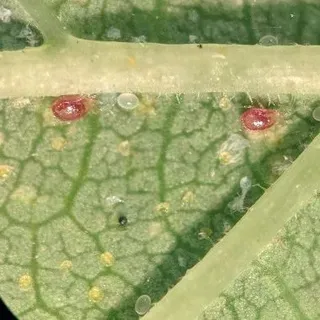Managing Spider Mites in Florida Hops
This publication is designed to provide information on managing spider mites on hops grown in Florida to hops growers, UF/IFAS Extension agents, and other crop protection professionals. Hops (Humulus lupulus L.) (Cannabinaceae), a new crop for Florida, has been studied at the UF/IFAS Gulf Coast Research and Education Center (GCREC) in Balm, Florida, since 2016. The hops plant produces flowers, also called cones, which are used to provide flavor and aroma to beer. A fall and spring crop have been cultivated in Balm each year since 2016, providing the opportunity to observe pests and evaluate pest management strategies over several seasons. Spider mites (Trombidiformes: Tetranychidae) have been consistent pests of hops at GCREC each season. Spider mites observed at GCREC include the two-spotted spider mite, Tetranychus urticae C. L. Koch (Figure 1), and red spider mites, Tetranychus spp. (Figure 2). (Specimens could only be identified to genus, as males are required to identify to species, and males were not present in samples submitted.) The two-spotted spider mite has five life stages: egg, larva, protonymph, deutonymph, and adult. Spider mites have a rapid life cycle and can develop from egg to adult in 8–12 days at 30°C (86°F) (Laing 1969). Females can produce 5–6 eggs per day and 60–120 eggs in their lifetime.
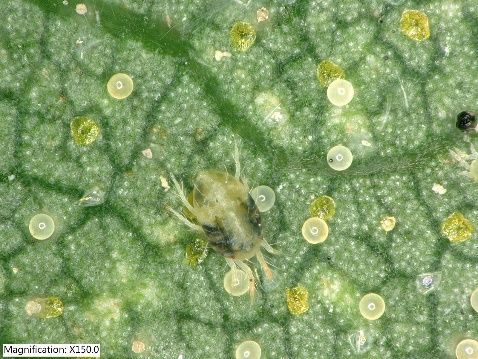
Credit: Hugh Smith, UF/IFAS
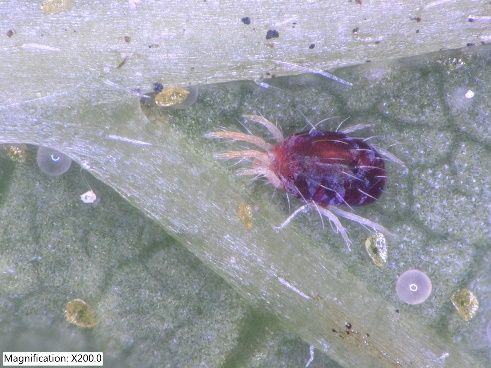
Credit: Hugh Smith, UF/IFAS
Infestation
Spider mite infestations tend to start on the underside of the hops leaf near the midvein. All life stages will be present, and as infestations develop, characteristic webbing appears. Spider mites puncture individual plant cells and feed on the contents, producing patches of dead cells on the leaf surface (Figure 3). Economic injury levels for spider mites on hops have not been established. However, research from Germany indicates that hops can tolerate high levels of spider mite infestation without significant reduction in yield (Weihrauch 2005). Spider mites do not usually feed on hops cones, and therefore do not damage the marketable portion of the crop. High densities of spider mites presumably may reduce cone production, but more research is needed to definitively determine that dense spider mite infestations can reduce hops yields. Spider mites do not transmit viruses or other pathogens that impact hops health.
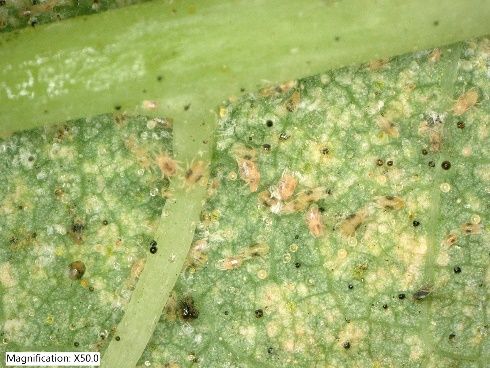
Credit: Hugh Smith, UF/IFAS
Miticides
Table 1 lists miticides registered for use on hops in Florida, including information on the number of times the miticide can be applied per crop and the mode of action number as defined by the Insecticide Resistance Action Committee (https://irac-online.org/). Consult product labels before use and follow all label directions and restrictions. There are five mode of action groups available for use on hops to manage mites: groups 6, 10, 20, 21, and 23. These different mode of action groups represent distinct pathways for reducing mite populations. For more information on modes of action, please consult “Understanding Insecticide Modes of Action and Resistance Management in Florida Horticulture” (https://doi.org/10.32473/edis-IN1379-2022). Except for abamectin (Agri-Mek SC), none of these miticides are restricted use materials. Restricted use pesticides can only be used by a certified pesticide applicator or under the supervision of a certified applicator. Insecticides are grouped in this category because of risks associated with human and environmental health.
Table 1 also includes information on the preharvest interval for each miticide. The preharvest interval is the amount of time, usually expressed in days, that must elapse between the last application of the pesticide and the initiation of harvest. Each miticide has a preharvest interval of at least 7 days, and abamectin has a preharvest interval of 28 days.
There are biopesticides available for the management of spider mites that can be applied until the day of harvest, but their efficacy on spider mites affecting hops in Florida has not been evaluated. Biopesticides include insecticidal soaps, oils, botanical products, and microbial insecticides. Most biopesticides kill in a way that does not select for resistance and so are not assigned an IRAC mode of action number. Please consult “Biopesticides and Alternative Disease and Pest Management Products” (https://doi.org/10.32473/edis-cv295-2021) for additional information on biopesticides.
Other Pests
Other pests have been observed on hops at GCREC, including stink bugs, caterpillars, thrips, lace bugs, and mealybugs (Table 2), and melon thrips (Thrips palmi) has been collected from hops cones. None of these pests has been observed damaging cones or reaching damaging levels on hops foliage. Beneficial arthropods have also been observed on hops at GCREC, and caterpillars collected for identification are often parasitized by parasitic wasps. Controlled pest management studies have not been carried out, however the impression from multiple seasons of growing hops at GCREC is that natural enemies (predators and parasitoids) will suppress pests, except for spider mites, below damaging levels in the absence of insecticides. Application of insecticides seems to flare other pests, perhaps by impacting naturally occurring natural enemies while not providing effective suppression of pest populations. This may be due in part to inadequate coverage provided by insecticide fogging equipment, particularly in the upper hops canopy (Smith et al. 2021).
Phytoseiulus persimilis
Since 2019, releases of the predatory mite Phytoseiulus persimilis Athias Henriot (Mesostigmata: Phytoseiidae) have been evaluated for management of spider mites in hops (Figure 4). Phytoseiulus persimilis pass through egg, larval, and nymphal stages before becoming adults. Eggs hatch in 2–3 days. The larval stage does not feed, but nymphs and adults feed on all stages of prey. Development time from egg to adult ranges from about 25 days at 15°C (59°F) to 5.0 days at 30°C (86°F). Females may live up to 50 days and can produce approximately 60 eggs in their lifetime (Hoffman and Frodsham 1993).
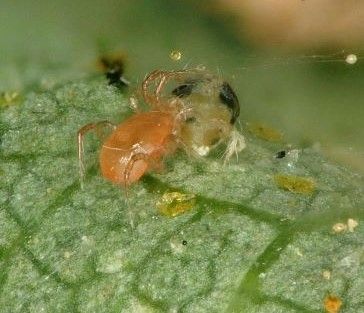
Credit: Lyle Buss, UF/IFAS
In some seasons, 3–4 releases of P. persimilis were made on hops at GCREC without miticide applications. In other instances, miticides were applied after two releases of P. persimilis. The level of control provided by sole reliance on predator releases was similar to the level of control provided when miticide applications followed predator releases. Figure 5 presents mean numbers of spider mite eggs and motiles (immature stages and adults) from the upper canopy (5 m [16.4 ft] above the ground) and lower canopy (1.5 m [5 ft] above the ground) of hops in relation to two releases of P. persimilis during the fall of 2019 at GCREC. Spider mite numbers were reduced to negligible levels by three weeks after the second release of P. persimilis. Data from 2019 indicate that spider mite numbers tend to be higher in the upper canopy than at ground level. However, scouting the upper canopy requires a lift, which is not practical for most growers (Figure 6).
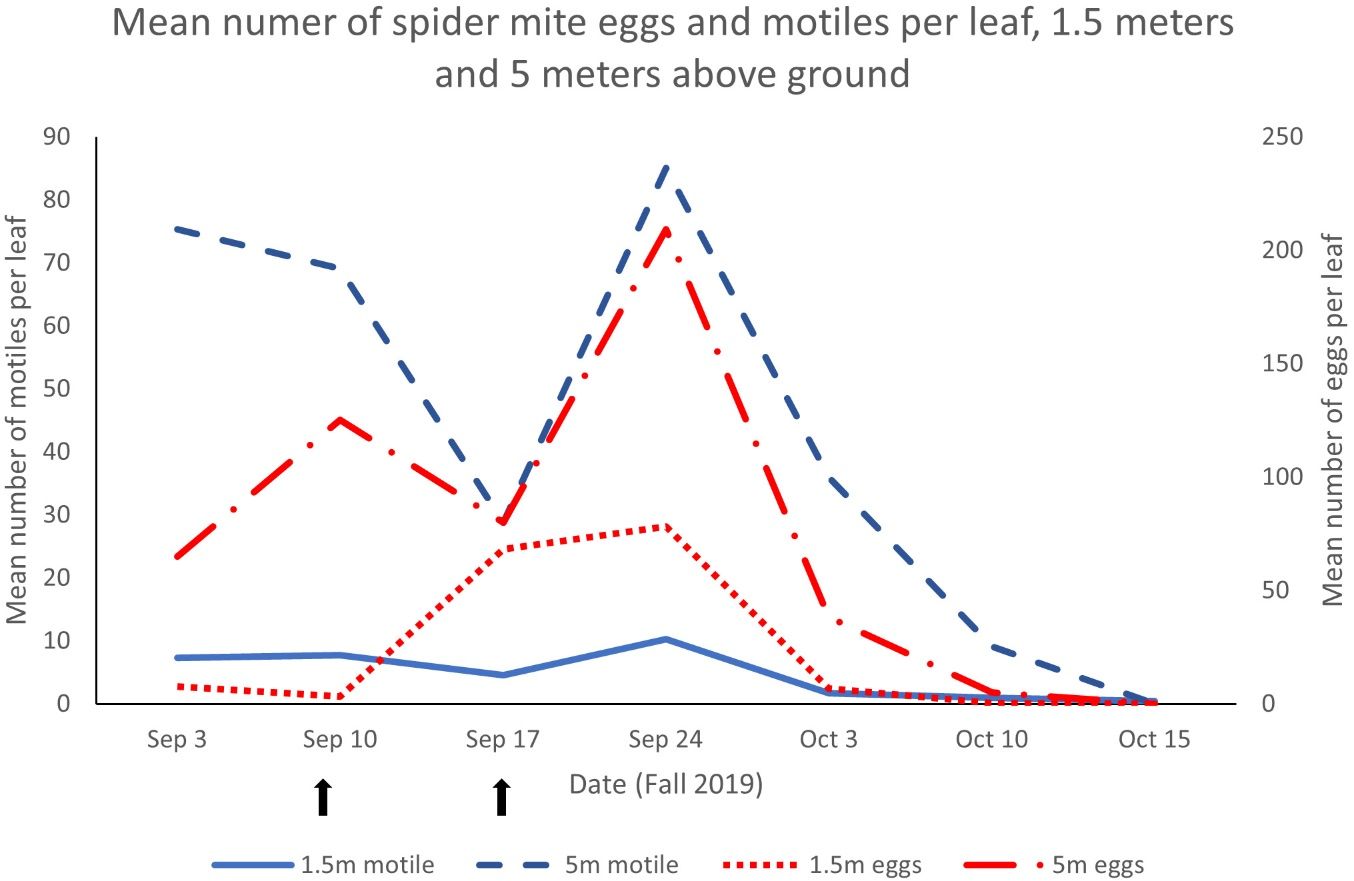
Credit: UF/IFAS
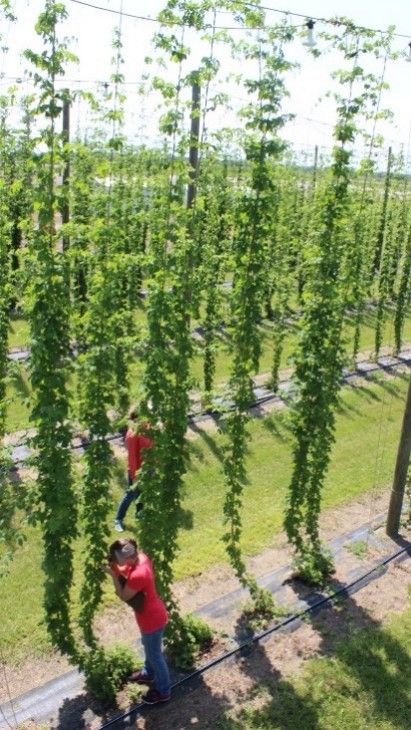
Credit: Hugh Smith, UF/IFAS
Scouting
In preparation for weekly monitoring of spider mites and other pests, it is useful to create a map of the production area and print it out to make notes of pest numbers while scouting. At GCREC, 100 plants are examined each week. The number of plants scouted will depend on the size of the hopyard and the resources available. Ideally at least ten percent of the plants in the hopyard will be examined. When scouting, it is important to enter the hopyard from a different point each week and to follow a different pattern so that different plants are examined each week. If possible, collect leaves from different levels within the canopy. This is the best way to detect new infestations and to track established infestations. Examine the underside of three or four leaves on the selected plants. Note the presence or absence of spider mites on the plant. Record information on the severity of the infestation if possible (for example, low = < 5 spider mites per leaf; moderate = 6–10 spider mites per leaf; high = > 10 spider mites per leaf).
Predator Releases
When the number of hops plants with spider mites approaches ten percent, the predatory mite Phytoseiulus persimilis can be ordered from a commercial insectary for the first release into the hopyard. Phytoseiulus persimilis usually needs to be ordered several (5–7) days in advance, but they are shipped by overnight delivery to maintain their viability. They should be applied to the hopyard the day they arrive or the following day. If the mites are not released immediately, they should be stored in a cooler, not the refrigerator.
Phytoseiulus persimilis can be purchased in different quantities and containers. Containers of 2,000 P. persimilis are common. Containers include vermiculite or a similar material. One shake of the container should deliver about five mites (Figure 7). At GCREC one shake is applied to the base of every plant in the hopyard, although P. persimilis could be applied at a lower frequency if the spider mite population is low. One container of 2,000 P. persimilis is enough to treat about 400 plants.
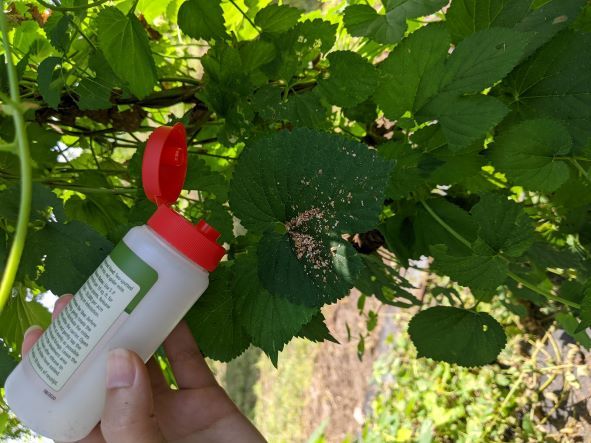
Credit: Hugh Smith, UF/IFAS
Phytoseiulus persimilis are a distinctive pale ruby color, and their legs are longer than the legs of spider mites. Some spider mites are dark red, so it should not be assumed that all red mites are P. persimilis. The eggs of P. persimilis and other phytoseiid (predatory) mites are oval, whereas the eggs of spider mites are globe-shaped. With practice, it is possible to distinguish predatory mites from pest mites and to keep track of the relative numbers of each over time after releases of predators are made.
After P. persimilis are released, weekly scouting should continue, and the presence of P. persimilis and other predators should be noted in addition to the presence of spider mites and other pests. The ratio of predatory to pest mites should shift in favor of the predators by two weeks after predator releases. Resealable plastic bags can be taken to the field and used to collect samples to examine under a microscope or submit to a specialist for identification. As the development of pest and predatory populations is tracked over time, it is important to keep in mind that warm, dry weather favors the development of spider mite populations, and rainy weather can put spider mites at a disadvantage.
Several naturally occurring predators have been observed in hops at GCREC attacking spider mites, including Amblyseius and Neoseiulus (Figure 8) species of predatory mites. Like P. persimilis, they both have legs that are longer than spider mite legs. The primary difference between these naturally occurring predatory mites and P. persimilis is that P. persimilis only feeds on spider mites, while Amblyseius and Neoseiulus mites attack other small, soft-bodied arthropods and can survive for a period of time on pollen.
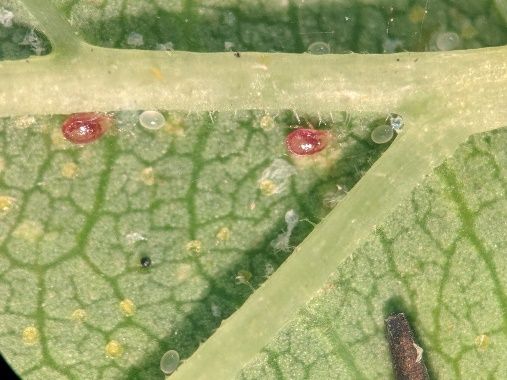
Credit: Hugh Smith, UF/IFAS
In addition to naturally occurring mite predators, insect predators of spider mites in hops have also been observed on hops at GCREC. Stethorus is a genus of predatory beetles related to ladybird beetles that are sometimes found feeding on spider mites in hops at GCREC (Figure 9). Green lacewing larvae (Chrysopa spp.) have also been observed feeding on spider mite eggs in hops.
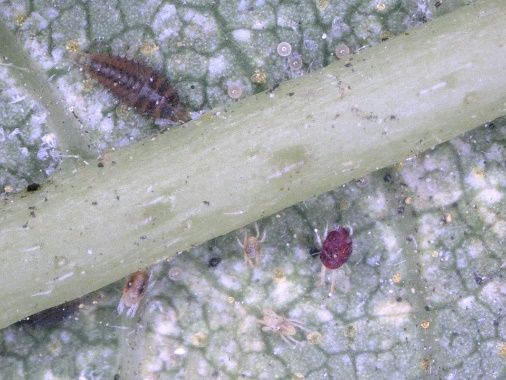
Credit: Hugh Smith, UF/IFAS
Several factors can influence the success of predatory mite releases for managing spider mites in hops, including the level of infestation when releases are initiated, the quality of the predators received, and weather conditions. Predator releases are initiated at GCREC when spider mite populations reach near ten percent of plants inspected. There are several producers of P. persimilis in the United States and elsewhere. Predator quality can be influenced by rearing conditions and the distance predators must be shipped to the release site. It is preferable to purchase P. persimilis directly from the producer rather than via an intermediary because this reduces the amount of time predators spend in transit, which can influence their survival and viability upon arrival. Extremes of weather and exposure to insecticides can also undermine predator efficacy. Maintaining spider mite numbers to fewer than five mites per leaf is optimal.
References
Hoffmann, M. P., and A. C. Frodsham. 1993. Natural Enemies of Vegetable Insect Pests. Cooperative Extension, Cornell University, Ithaca, NY. 63 pp.
Laing, J. E. 1969. “Life History and Life Table of Tetranychus urticae Koch.” Acarologia 11:32–42.
Smith, H. A., M. Hennessey, A. Furuya, E. Munthali, B. Rossitto de Marchi, and S. Agehara. 2021. “Pests of Florida Hops: Preliminary Observations.” Florida Entomologist 104: 51–53. https://doi.org/10.1653/024.104.0108
Weihrauch, F. 2005. “Evaluation of a Damage Threshold for Two-Spotted Spider Mites, Tetranychus urticae, in Hop Culture.” Annals of Applied Biology 146: 501–509. https://doi.org/10.1111/j.1744-7348.2005.040163.x
Table 1. Miticides registered for use on hops in Florida: Product name, re-entry interval (REI), International Resistance Action Committee Mode of Action (IRAC MoA) number, acre rate, and notes including pre-harvest interval (PHI). Contact: Hugh A. Smith, hughasmith@ufl.edu; 813-419-6588.
Table 2. Some arthropods collected from hops (Humulus lupulus) at GCREC, Balm, FL, 2016–2020.




